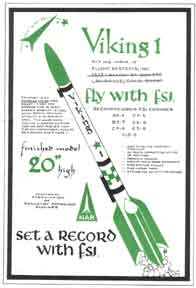The following is completely beside the point, Andrew, so just skip over it.
OK, John:
If you read the articles that I linked to, you will see that Larry Brand mentioned the lengths that he made the tube fins. In all three, the tubes were shorter than their diameters. For example, in one he used 3" diameter tubes that were 2.75" in height. His Aquafina was just the most dramatic example of this that I could find in a quick survey of his many articles about tube-finned rockets on EMRR.
What I was trying to do in my response was to provide definitions of "ring fins" and "tube fins" that were free of any mention of height. The reason was that I don't think that the cylinder height has anything with whether a circular stabilizer on a rocket is a ring fin or a tube fin. I realize that a discussion of what to call them is really pedantic, because it doesn't affect in any way how we use them. But like any profession, academic field or even hobby, we have our own language and vocabulary, and so we should recognize that our terms have precise meanings and that we all understand and agree about what our terms mean.
Tube fins do not have to be taller than their diameter, as I mentioned above. And ring fins do not have to be shorter than their diameter, either. Did you take a look at the
Estes World Federation Star Probe? Most people would call the cylinder at the aft end of the model a ring fin, but as you can see, it is considerably longer than its diameter. In fact, the part that was used was BT-80S, which measured 2.6" in diameter and 4.5" tall. Since tube fins can be shorter and ring fins taller than their diameter, then the length (or height) of the component doesn't really have anything to do with whether we should call it one type or the other.
In my last post, I rashly (even foolishly) went out on a limb and attempted to describe the one characteristic that I saw as distinguishing a ring fin from a tube fin. When we see something that is called a ring fin, it is just about always positioned so that the center of the ring's diameter is in the same spot as the center of the airframe's diameter; in other words, they are concentric. Whenever we see something that we call a tube fin, it is always positioned along or immediately adjacent to the airframe's perimeter. The center of the tube fin's diameter is never concentric with the airframe's diameter; in fact, it is always positioned completely outside of the airframe's perimeter.
When I went on to define a ring fin, I wanted at first to include the requirement that it be concentric with the airframe. That is almost always what we see, after all. But then I realized that a rocket could have one or more ring fins that were "off center", so that the the center of the ring's diameter was not in the same place as the airframe diameter's center. But if it was far enough off to the side that all or nearly all of the ring fin was outside of the airframe's diameter, it would meet my definition of a tube fin. So I came up with the requirement that the center of the airframe's diameter had to fall within the perimeter of the ring in order for the attachment to be called a ring fin.
An analogy would be with the game of horseshoes; in order for the thrown shoe to be a "ringer," it just needs to land in such a way that the post is somewhere within the incomplete circle made by the arms of the shoe. If the "post" (the center of the airframe's diameter) is within the circle described by a cylindrical stabilizer, that stabilizer is a "ringer."
If the center of the airframe's diameter falls outside of the circle described by a cylindrical stabilizer that is attached to it, the stabilizer is called a tube fin. Note that according to this definition, the entire circle described by the tube fin does not have to be outside of the airframe. That is almost always how they are positioned, though.
The FlisKits
Borealis and the
Dead Ringer both utilize very large, thin sections of tubing (rings) for stabilization. But because the center of the fuselage or airframe diameter is outside of all of these rings in both cases, the rings on these two models are, in fact, tube fins.
In no way did I post this to disparage your earlier comments. This is simply a discussion about which term to apply to these structures when they are placed on a rocket. Your comments, and those of anyone else who wants to wade into this swamp, are welcome.
Now back to our regularly schedule program, which is already in progress.
MarkII

















